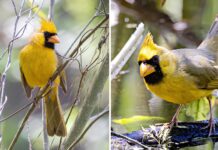The first reports of deadly chimp assaults on gorillas have been published. Although this demonstrates that our closest ancestors can endanger individuals only a few generations distant, a report published in Scientific Reports suggests that the ultimate cause may be us.
Loango National Park in Gabon is home to chimps as well as western lowland gorillas. For the past 16 years, it has also incorporated the Loango Chimpanzee Project, a study of chimp troop connections.
Chimpanzees are undoubtedly the most warlike of the big apes (humans apart), yet for the most of the period the team has been watching them, they have taken out their aggression on other members of their species or smaller animals. Longer-term monitoring efforts have revealed the same result elsewhere.
“Interactions between chimps and gorillas have so far been considered relatively relaxed,” stated Osnabrück University Professor Simone Pika in a statement. “We’ve seen both species interacting peacefully in foraging trees on a regular basis.” Our Congolese colleagues also saw playful exchanges between the two great ape species.”

All of that changed two years ago, when Osnabrück PhD student Lara Southern and colleagues heard shouts typical of a hostile confrontation between two monkey populations. “Then we heard chest beats, a gorilla-like display, and realized the chimps had encountered a group of five gorillas,” Southern explained.
The battle lasted 52 minutes. Ten months later, project members saw a lengthier disagreement. In both situations, the chimps utilized number weighting (27 to 5 and 7, respectively) to offset the gorillas’ significant size advantage. The first encounter saw some fighting on both sides, but the second featured chimps pursuing gorillas up and down trees, then assaulting them as they tried to flee through the canopy and onto the ground.
Each time, the adult gorillas escaped, but a baby was removed from its mother and murdered. In the initial combat, three chimps were hurt.
West African chimps had been thought to be less hostile toward members of their own species than East African counterparts, but Southern recently revealed that Loango’s “annual inter community killing rate was among the highest across all sites.”
Naturally, the authors of the article want to know why the assaults happened and why they happened now. Both instances occurred during seasons when the diets of chimps and gorillas overlapped considerably, whereas the amicable exchanges occurred when their diets diverged.
The scientists believe it is no coincidence that Gabon’s woods have begun to produce less fruit as a result of climate change. The second deceased infant gorilla was eaten by a chimp, but the first was not viewed as food, at least not at first, suggesting that the violence was caused by competition for resources rather than direct predation.
“We are only beginning to understand the effects of competition on interactions between the two great ape species in Loango,” Pika explained. “Our study shows that there is still a lot to explore and discover about our closest living relatives, and Loango National Park, with its unique mosaic habitat, is a unique place to do so.”






